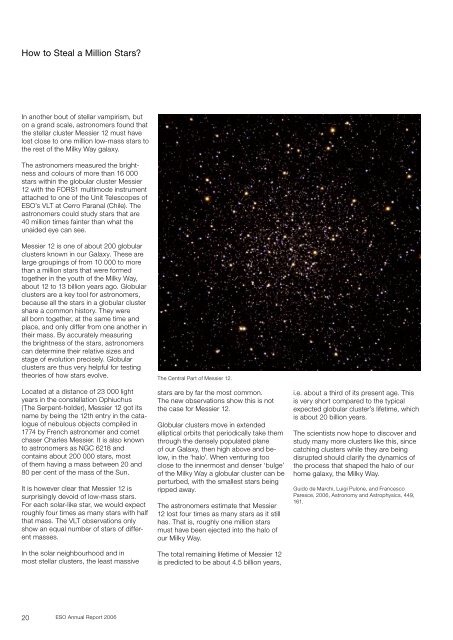Untitled - ESO
Untitled - ESO
Untitled - ESO
You also want an ePaper? Increase the reach of your titles
YUMPU automatically turns print PDFs into web optimized ePapers that Google loves.
How to Steal a Million Stars?<br />
In another bout of stellar vampirism, but<br />
on a grand scale, astronomers found that<br />
the stellar cluster Messier 1 must have<br />
lost close to one million low-mass stars to<br />
the rest of the Milky Way galaxy.<br />
The astronomers measured the brightness<br />
and colours of more than 16 000<br />
stars within the globular cluster Messier<br />
1 with the FORS1 multimode instrument<br />
attached to one of the Unit Telescopes of<br />
<strong>ESO</strong>’s VLT at Cerro Paranal (Chile). The<br />
astronomers could study stars that are<br />
40 million times fainter than what the<br />
unaided eye can see.<br />
Messier 1 is one of about 00 globular<br />
clusters known in our Galaxy. These are<br />
large groupings of from 10 000 to more<br />
than a million stars that were formed<br />
together in the youth of the Milky Way,<br />
about 1 to 13 billion years ago. Globular<br />
clusters are a key tool for astronomers,<br />
because all the stars in a globular cluster<br />
share a common history. They were<br />
all born together, at the same time and<br />
place, and only differ from one another in<br />
their mass. By accurately measuring<br />
the brightness of the stars, astronomers<br />
can determine their relative sizes and<br />
stage of evolution precisely. Globular<br />
clusters are thus very helpful for testing<br />
theories of how stars evolve.<br />
Located at a distance of 3 000 light<br />
years in the constellation Ophiuchus<br />
(The Serpent-holder), Messier 1 got its<br />
name by being the 1 th entry in the catalogue<br />
of nebulous objects compiled in<br />
1774 by French astronomer and comet<br />
chaser Charles Messier. It is also known<br />
to astronomers as NGC 6 18 and<br />
contains about 00 000 stars, most<br />
of them having a mass between 0 and<br />
80 per cent of the mass of the Sun.<br />
It is however clear that Messier 1 is<br />
surprisingly devoid of low-mass stars.<br />
For each solar-like star, we would expect<br />
roughly four times as many stars with half<br />
that mass. The VLT observations only<br />
show an equal number of stars of different<br />
masses.<br />
In the solar neighbourhood and in<br />
most stellar clusters, the least massive<br />
0<br />
<strong>ESO</strong> Annual Report 006<br />
The Central Part of Messier 1 .<br />
stars are by far the most common.<br />
The new observations show this is not<br />
the case for Messier 1 .<br />
Globular clusters move in extended<br />
elliptical orbits that periodically take them<br />
through the densely populated plane<br />
of our Galaxy, then high above and below,<br />
in the ‘halo’. When venturing too<br />
close to the innermost and denser ‘bulge’<br />
of the Milky Way a globular cluster can be<br />
perturbed, with the smallest stars being<br />
ripped away.<br />
The astronomers estimate that Messier<br />
1 lost four times as many stars as it still<br />
has. That is, roughly one million stars<br />
must have been ejected into the halo of<br />
our Milky Way.<br />
The total remaining lifetime of Messier 1<br />
is predicted to be about 4.5 billion years,<br />
i.e. about a third of its present age. This<br />
is very short compared to the typical<br />
expected globular cluster’s lifetime, which<br />
is about 0 billion years.<br />
The scientists now hope to discover and<br />
study many more clusters like this, since<br />
catching clusters while they are being<br />
disrupted should clarify the dynamics of<br />
the process that shaped the halo of our<br />
home galaxy, the Milky Way.<br />
Guido de Marchi, Luigi Pulone, and Francesco<br />
Paresce, 006, Astronomy and Astrophysics, 449,<br />
161.

















